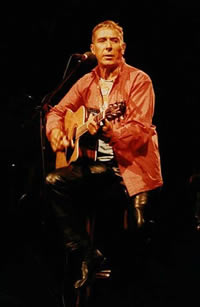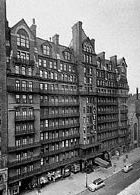

The Text Files

Chelsea mourning
This text was published in The Observer, September 3, 2000
'I can still hear the sound of the Methodist bells,
I'd taken the cure and had just gotten through
Staying up for days in the Chelsea Hotel
Writing Sad-Eyed Lady of the Lowlands for you'
'Sara' by Bob Dylan (1975)
Bob Dylan got married during his three-year stay in the Chelsea Hotel from 1961-64, and his first child Jesse was born there. After first arriving at the hotel in 1963, Viva (who went on to become an Andy Warhol superstar) gave birth to both Gaby and Alexander and married both her husbands during the 25 years she lived there. Leonard Cohen, however, preferred to write 'Chelsea Hotel No 2', a song commemorating fellatio with Janis Joplin in room 104, when he lived there in the 1970s. Patti Smith first stayed there in 1959, and in 1962-63 returned with a penurious Robert Mapplethorpe who could not persuade the owner Stanley Bard that his photography made an equitable exchange for rent. Stanley let them stay anyway. Joni Mitchell had 'Chelsea Morning'. Bon Jovi had 'Chelsea Midnight' and Nico and Andy Warhol had Chelsea Girls.
Stanley Bard has been at the helm of the Chelsea Hotel for more than 40 years, since taking it over from his father David in 1957. The building was the first co-oped building in New York, having been built, complete with features such as artist studios, in 1882. It became a hotel in 1905, ended in bankruptcy, and rescued from the bank by a group led by David Bard in 1940. Now featuring 400 rooms, it has been the recent focus of morbid rumours of its imminent sale. It's not happening. What seems to have happened is that attention has been drawn to New York's Chelsea area in general as a result of the recent move there by so many art galleries, filling the blocks from 10th Ave and 24th St West to 11th Ave and 26th.
In its relationship with the various art movements that flowed through New York, the hotel under Stanley's watchful eye, was always a noteworthy recipient of those fringe, and sometimes mainstay, figures that were active then. The list is long and fearsome, something like the opening verses of Genesis. It begins with Brendan Behan who needed to finish two books for Geiss and was allowed in on the proviso that there was 'no destruction of property'.
He was followed by Dylan Thomas, whom Stanley remembers as being inebriated all the time (but then, 'they're all like that over there!'). The now legendary film-maker Harry Smith, who had been living in the hotel while contriving his Folklore Anthologies hung out with Allen Ginsberg, who then brought around Dylan and Cohen. Along with Aaron Copland, the most important American composer of his generation, Virgil Thompson lived in the most elegant of the rooms (a five-room apartment), until his death seven years ago. The wood appointments were my most vivid memories of that floor complete with a Steinway Grand and rich, dark wood surroundings.
In 1967, I met the young designer Betsey Johnson in a long narrow room with a small bed at one end and Betsey's sewing machine at the other. Over a sleepless three days, she completed the costumes for Ciao Manhattan, and although they were the most disturbing costumes she had ever designed, she became instantly famous for her mini-skirt (simultaneously with Mary Quant in London) and Story of O dress.
Another member of the Andy Warhol Factory, Danny Fields, held an Assassination Party on the Thanksgiving after JFK's assasination - to lift people out of their gloom. There he met Nico, a Teutonic vision of an ice-maiden, and introduced her to Warhol. He also took Leonard Cohen to visit Edie Sedgewick at the Chelsea. Edie was the daughter of an owner of the Southern Pacific Railroad who was introduced to AW by Barbara Rubin, a Lower East Side film-maker, whom she had met during a recent stay in a mental home. Barbara had taught her how to stay slim (throwing up after meals). Leonard left her room greatly concerned at the way her room seemed to overflow with candles in what looked to him like a foreboding vision of the future. He wasn't wrong. Edie was soon burnt out of the Chelsea and out of her apartment in separate incidents. It was at that time that I first saw her in the Factory, her arms heavily bandaged, which only served to accentuate her Jean Seberg-like fragility.
If you were indigent and had a partying nature, then it was imperative you found a place to crash for the night, and if you didn't already have a room to go to, then you would surely know someone who knew someone who knew where the action was... and this was invariably at the Chelsea. This partying vortex echoed the same moveable feast one encountered at Andy Warhol's Factory, when Andy and Edie, the young poet and photographer Gerard Malanga, and Andy's 'discovery' Ingrid Superstar moved en masse around the Manhattan salons. It was the networking style of the day.
I recall the days when they disappeared to 23rd St to shoot Chelsea Girls because the Factory was forlorn and empty, no silk screens stretched out on the floor, and more ominously no opera! Stanley remembers the soothing gloss Andy put on the filming of Chelsea Girls, seeking to persuade him of the positive effect it would have on the image of the hotel. Stanley would not have it. Still, he signed the release for Paul Morrissey and has never seen the movie to this day.
Piero Heliczer as the link between the Factory and the Velvet Underground, and was already documenting the Lower East Side, when Paul Morrissey saw us play and offered to manage us. It was the beginning of a dizzying four years in which we went from total anonymity to great renown. A vertical path that proved too much for our centre of gravity. It gave each of us in the band the bends from which we never quite recovered. Although we tried to focus on the music, the tug of war between Andy's artworld panache and the more crude demands of rock'n'roll street life, never allowed for an amicable resolution.
For one reason or another, I view this period, with its misplaced gaiety, as a wholly owned subsidiary of the people who helped the art get made. Misplaced in the sense that Vietnam was the backdrop and art was a versatile posture, arrogant and unforgiving of loss of life. Amphetamines are thirsty work: they were the viral bone-meal of creativity in the 60s.
Stanley Bard is today the last of a line of art mavens who from the sidelines helped many a young artist in need who would otherwise have slipped through the net. He took what was handed him and rode with it. Stanley's philosophy of mentoring is down to earth. He viewed Andy as trustworthy: artistically... but not into the far ether. When he allowed Robert M to live there rent-free with Patti in 1962-63 he was persuaded by Mapplethorpe's conviction that he would have money very soon... but demurred when he saw what was offered, Robert's photo-prints of his dying friends.
This kind of story happened frequently in those early days. A frequent figure at the Factory, Danny Fields took Nico to see a dentist (his uncle) who was offered a Warhol painting in lieu of his services, but who turned it down.
The lobby of the hotel was so furry with art from its tenants that it has never fully moved away from being an overgrown taxidermist's Valhalla. The ghosts, the plaques, the fame, still ooze from the walls. Furry people, too. Werewolves of Chelsea. Limited always to the 2nd floor, where the cleaning staff entered with caution, eyes down for glass, peering through the door into the bath, the discipline of homicide detectives.
Every nascent movement has its benefactors, detractors, hangers-on and champions. In New York, movements have a way of coalescing around people and locations with their own unique built-in level of difficulty. The stand-offishness of the personages would often mimic the centre of gravity of the activities. We see this in New York with the case of the Mudd Club and its covert owner Steve Maas, and in Mickey Ruskin in the case of Max's Kansas City. Each of these individuals played a visceral role in the activities of the day. In Stanley Bard's case (no less than the others'), he gave shelter to those in need of it while completing their work. It was as if you gained diplomatic immunity the moment you entered the lobby.
This rings in one's ears when the story of Bill Graham and the opening of Filmore East is told. As well as wanting to open the San Francisco version of the hotel, since rockers were not welcome in any hotel in those days, he saw his friendship with Stanley as part of the solution as well as future commerce in the cloning of the Chelsea on the West coast. (Also there was Hilly, later at CBGB, who opened and developed a property on the Bowery where the derelict held court over the dissolute, and where musicians scampered in and out of the club heaving their heavy equipment under the doleful gaze of the street people hungry for knowledge of any spectacle beyond the gutter. Hilly, meanwhile, could, on any lazy afternoon, be found roaming the chairs and tables of the empty bar with his acoustic guitar singing his favourite Gilbert & Sullivan songs in a rich, operatic baritone. The punk movement was not his only home from home.)
All these years later, Max's has closed down, the Mudd Club has moved, but the Chelsea is still there, like a stately lady, slightly run down. Now I have mixed feelings about her. Although the aura of that icon of the 60s is still intact, for many of us those days had lustre but too much confusion. If only the delivery had been better... if only the song was in tune... if only the fame had lasted... if only the truth were known... if only the drugs were free... if only we hadn't lost the sight... if only the film was in focus... if only the money was in the bank... if only art would last forever...